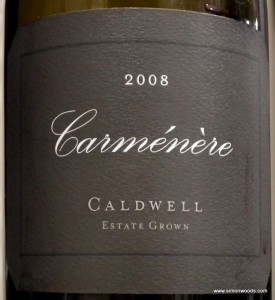Just getting to the end of a fascinating week in Napa Valley. Was at Bond winery last night for a superb farewell meal prepared by team from the now-3-starred restaurant at Meadowood Resort with accompanying wines from Schramsberg, Clos du Val, Silver Oak, Rubicon and of course Bond. After our pudding plates had been enthusiastically scraped clean, Estate Director Paul Roberts MS asked us a question – what had been our highs and lows of the week? Some of the lows were expected – alcohol levels, price, over-extraction – while a few of the highs, mostly from the purple lips of Oz Clarke, were unprintable, but involved references to various ladies he’d encountered.
My high and low were related. The low was that in a region that, as had been hammered into us several times throught the week, has widely differing soils, temperatures, rainfall, aspects etc – various terroirs in other words – there was such a focus on one grape variety, namely Cabernet Sauvignon. There is some terrific Cabernet produced here, usually from vineyards with slopes and well-drained soils, but there is also rather a lot of ho-hum, me-too wine. And just as in other parts of the wine world, these hang on the coat-tails of the top wines and command prices that just have you shaking your head in bemusement.
My high was that despite this dominance of Cabernet, it’s still possible to find other grapes strutting their stuff. For those who’ve dismissed it in the past, Napa Sauvignon is worth re-examining, while for anyone who can find it, the Syrah can also be excellent – why aren’t Americans drinking more of it? Most people here seem to keep quiet about Pinot Noir, but it can be excellent (the delicious wines of Ancien were new me), as can the Chardonnay. Then there have been examples of Riesling, Grüner Veltliner, Nero d’Avola, Petite Sirah, Flora, Chenin Blanc, Roussanne, Albariño, Grignolino, Charbono, Carignan, Tempranillo and Aglianico – not all were great, but they showed that was still life beyond Cabernet. And in the Bordeaux family of grapes, Cabernet Franc has been a highlight (Paradigm is a star), while Petit Verdot (intriguing if slightly stolid) and Malbec (more wildness, freshness and fragrance) are also gaining traction. But I also came across this Carmenère from Caldwell Vineyard. I’m not quite sure whether its $95 price tag makes it the world’s most expensive Carmenère, and I wish (as with many Napa wines) that the winemaker had been a little lighter-handed with the oak. However, its smoky, herby intensity and flavours of dark plummy black fruit tinged with chocolate show that it could have a future in the warmer parts of the valley – watch out Chile…

Simon,
G-D it. I spend over $100,000 per year on new french oak, barrel ferment the stuff, and you don’t like it. I’ve got to re-think our style……
Thank You so much for the great writeup and picture. Come by and taste with us the whole Caldwell spread. Marbue is making 16 wines from the 10 varieties in the Caldwell Vineyard. You’d love it.
John
Hi John, no, it’s not that I didn’t like it, just that I’d prefer to have seen what it was like in a less oaky state – the fruit looked very promising. Marbue also showed me the 07 Merlot and Caldwell Gold CS, both of which I thought were very good. With wiines like these, wouldn’t be surprised to see Coombsville getting its own AVA.
But after a week in Napa, I’d still say that I’d prefer a lighter hand all round with oak. Would love to see some people trying unoaked Cab Franc from Coombsville, Carneros, bottom end of Mt Veeder for example